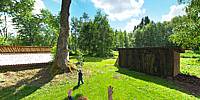
St. John's Day 2011
Grove of Stone Farm, Pärnu County, Estonia
June 24, 2011, 14:10 local time
© 2011 Andrew Bodrov, All Rights Reserved.
Jaanipäev - St. John's Day
June 24, An Important National Cultural Holiday
Aside from Christmas, Jaaniõhtu (Midsummer Eve) and Jaanipäev (St John's Day) are the most important days on the Estonian calendar. The short summers with brief nights hold special significance for the people of Estonia. Jaanipäev follows the longest day (21 June) of the year, or the Summer Equinox, when night seems to be non-existent.History of St. John’s Day
Thousands of bonfires are lit all over Estonia on St. John's Day. Jaanipäev was celebrated long before the arrival of Christianity in Estonia, although the day was given its name by the Crusaders. The arrival of Christianity, however, did not end pagan beliefs and fertility rituals surrounding this holiday. In 1578, with some disgust, Balthasar Rüssow wrote in his Livonian Chronicle about Estonians who placed more importance on the festival than going to church. He complained about those who went to church, but did not enter, and instead spending their time lighting bonfires, drinking, dancing, singing and following pagan rituals.Significance
Midsummer's eve is important for lovers. In Estonian fairy tales and literature there is the tale of two lovers, Koit (dawn) and Hämarik (dusk). These two lovers see each other only once a year and exchange the briefest of kisses on the shortest night of the year. Earth-bound lovers go into the forest looking for the flower of the fern which is said to bloom only on that night. Also on this night, single people can follow a detailed set of instructions to see whom they are going to marry. On Jaaniõhtu, Estonians all around the country will gather with their families, or at larger events to celebrate this important day with singing and dancing, as Estonians have done for centuries.Source: www.estonia.eu


 Tap or click the zoom icon in the bottom right corner of the picture to switch between in-page and fullscreen view
Tap or click the zoom icon in the bottom right corner of the picture to switch between in-page and fullscreen view